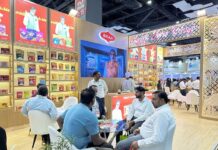
Jörg Willburger, Product Manager Track and Trace at Syntegon Technology, is convinced that traceability is a top priority for the food industry. More and more countries are announcing the introduction of stricter regulations in the wake of shocking scandals. However, early voluntary serialization of food products also holds great potential. Learn how food manufacturers can master the challenges and benefit from cooperation with experienced partners in the following interview.
Interviewer – Mr Willburger, why should the food industry address serialization now?
Jörg Willburger – Counterfeiting is a hot topic in almost all manufacturing industries. Cases such as the fatal scandal in China, where contaminated baby milk powder claimed several lives, are pushing the demand for an unambiguous proof of origin. To strengthen trust in their own brand and avoid expensive product recalls, companies in all consumer goods sectors must take action as quickly as possible. If a manufacturer cannot provide trustworthy data, this will have a negative impact on the company’s reputation and ultimately on its profitability.
Many national regulatory authorities are currently considering new regulations specifically for food products. Russia, for example, has already introduced initial measures for the mandatory traceability of dairy and other goods. The FDA has also submitted drafts for more seamless traceability of food products, and similar plans are underway in China. If new regulations come into force in these important markets, producers from other regions will also have to comply to secure their market access.
Interviewer – Are there other benefits for manufacturers besides the legal requirements?
Jörg Willburger – The role of Track and Trace as a marketing tool should not be underestimated as a way of boosting consumer confidence and encouraging interaction with consumers through innovative advertising and gamification measures. With Track and Trace in place, companies no longer need to print large-scale information on the packaging. A code that consumers can simply scan themselves does the trick. Track and Trace solutions can also help the cost-sensitive industry to reduce food waste. For example, digital price displays in supermarkets can be automatically adjusted according to the best-before date.

Serialization solutions also provide essential data for the control and transparency of manufacturing and supply chain processes. What’s more, should product recalls ever be necessary despite all quality control measures, serialization makes this process a lot more efficient. Hence, serialization is vital for both consumers and manufacturers and can provide both sides with the desired transparency from farm to fork.
Interviewer – What are the biggest challenges for the food industry?
Jörg Willburger – The omnipresent cost pressure is a general challenge. The implementation of new systems initially involves investments that will only pay off in the longer term. If a country introduces new regulations at fairly short notice, companies could find themselves under extreme time pressure. That’s why I think it is very wise to address the issue of Track and Trace at an early stage. Whoever considers the requirements and possibilities of serialization now will be better prepared for future challenges.
Of course, there are also technical challenges. Track and Trace is not only about equipping a product with a serial number. You need equipment such as serialization modules, printers, lasers, cameras, etc. It is highly recommended to work with an experienced partner right from the start. Together, you can clarify what requirements the system needs to fulfill in both the short and long term and whether you need to invest in new machinery or in more cost-efficient upgrades of existing production equipment. Most importantly, the system should be scalable and as flexible as possible to allow for adaptations to changing requirements.
When implementing the software, the desired level of detail is the most important factor. Will the data only be used for in-house purposes? Should it be connected to external databases, or is it also intended for interaction with consumers? If you opt for an open solution right away, you avoid the so-called lock-in effect and get software that is compatible with a wide variety of programs. In addition, Track and Trace software is predestinated for use with Industry 4.0 applications, for example, for performance management or to increase OEE (Overall Equipment Effectiveness). Dashboards and data visualization provide a quick overview of the entire production.
Interviewer – How can Syntegon support food manufacturers in overcoming these obstacles?
Jörg Willburger – Apart from our open solutions, we have the required experience. We are familiar with strict regulations and have already installed more than 500 Track and Trace solutions for customers worldwide, especially in the highly regulated pharmaceutical industry. Our customers in the food industry benefit from this know-how since we can offer them turnkey solutions for a wide range of products. Accordingly, our portfolio ranges from cost-efficient entry-level solutions and high-speed lines to high-tech, fully validatable systems and complete turnkey solutions.
A new Track and Trace solution not only affects production equipment and software; it also changes the overall process landscape in the company. You need to adapt production steps, incorporate suppliers as well as cooperation and trading partners, and consider data management and security. In the end, it’s all about integration. We can seamlessly integrate our Track and Trace solutions into existing system landscapes at all levels and across all interfaces. What has already stood the test in other trades also applies to the food industry – an open system is a basic prerequisite for successful serialization or future aggregation. A good reason why Syntegon engages in the steering committee of the Open-SCS group to establish interoperable, standardized interfaces in a wide range of industries.
Interviewer – What first steps do you recommend for a company that wants to implement Track and Trace?
Jörg Willburger – First, companies should ask themselves what they expect from the serialization solution, what level of detail is needed now and in the long term. Beyond serialization at the package level and software, detail is important for aggregation and logistics – the traceability of outer packaging, bundles, cartons, or pallets. Here, too, Syntegon can provide support and many years of experience. We accompany our customers from conception to implementation and ongoing operations. If specifications change or customers want additional functions, we have efficient upgrade solutions in our portfolio. For those who want to go one step further, our SODA (Single Object Data Acquisition) solutions can complement classic Track and Trace by serializing each individual product at the start of production and tracking it seamlessly throughout production and packaging. This way, product recalls can be carried out in an even more targeted and selective manner to avoid unnecessary product losses and costs.
In general, a sound, future-oriented serialization system is modular, flexible, and scalable. It has open interfaces, allows vendor-independent integration into existing lines and IT architectures, and can be upgraded step by step without major effort. Food manufacturers who seize the opportunity to start with a pilot project now and test the first applications are well-positioned for upcoming regulatory challenges. In addition, they will have enough time to adapt the solution to specific requirements. This is exactly what we want to offer with the Syntegon solutions – a system that grows flexibly with requirements.

IndiFoodBev — authentic, impactful and influential
An English-language food and beverage processing and packaging industry B2B platform in print and web, IndiFoodBev is in its third year of publication. It is said that the Indian food and beverage industries represent approximately US$ 900 billion in revenues which implies more than 20% of the country’s GDP. Eliminating the wastage on the farmside can help to deliver more protein to a higher number of the population apart from generating sizable exports. The savings in soil, seeds, water, fertilizer, energy and ultimately food and nutrition could be the most immense contribution that country is poised to make to the moderation of climate change.
To improve your marketing and grow sales to the food and beverage processing and packaging industry, talk to us. Our research and consulting company IppStar [www.ippstar.org] can assess your potential and addressable markets in light of the competition. We can discuss marketing, communication, and sales strategies for market entry and growth.
Suppliers and service providers with a strategy and budget for targeted marketing can discuss using our hybrid print, web, video, and social media channels to create brand recognition linked to market relevance. Our technical writers are ready to meet you and your customers for content.
The second largest producer of fruit and vegetables in the world is continuously expanding processing capacities and delivery systems with appropriate innovative technologies. We cover product and consumer trends, nutrition, processing, research, equipment and packaging from farm to thali. Get our 2025 media kit and recalibrate your role in this dynamic market. Enhance your visibility and relevance to existing markets and turn potential customers into conversations. Ask for a sample copy of our bi-monthly in print or our weekly IndiFoodBev eZine each Wednesday.
For editorial info@ippgroup.in — for advertisement ads1@ippgroup.in and for subscriptions subscription@ippgroup.in
Naresh Khanna – 10 February 2025
Subscribe Now










